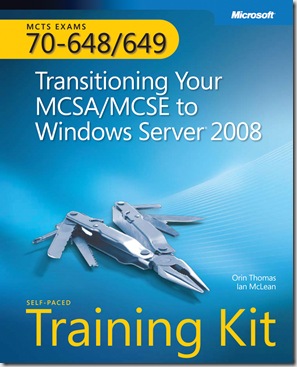New book: MCTS Self-Paced Training Kit (Exams 70-648 & 70-649): Transitioning Your MCSA/MCSE to Windows Server 2008
I’m very happy to announce the availability of a very eagerly awaited book -- MCTS Self-Paced Training Kit (Exams 70-648 & 70-649): Transitioning Your MCSA/MCSE to Windows Server® 2008.
This book covers both upgrade exams for Windows Server 2008. If you’re currently an MCSE on Windows Server 2003, passing the 70-649 exam earns you all three MCTS certifications for Windows Server 2008. Then passing the Pro-level exam 70-647, and either Vista exam 70-620 or 70-624, earns you the MCITP: Enterprise Administrator certification for Windows Server 2008.
If you’re currently an MCSA on Windows Server 2003, passing the 70-648 exam earns you two of the MCTS certifications for Windows Server 2008. Then passing the Pro-level exam 70-646 earns you the MCITP: Server Administrator certification for Windows Server 2008.
To give you a sampling of what you’ll find inside the book, we’ve included the Contents at a Glance, a brief excerpt from the Introduction, and one of the Real World sidebars:
Contents at a Glance
Introduction xxi
Chapter 1 Configuring Internet Protocol Addressing 1
Chapter 2 Configuring IP Services 59
Chapter 3 Network Access Configuration 119
Chapter 4 Network Access Security 165
Chapter 5 Configuring Active Directory Lightweight Directory
Services and Read-Only Domain Controllers 225
Chapter 6 Active Directory Federation Services and Active Directory
Rights Management Services Server Roles 281
Chapter 7 Active Directory Certificate Services 347
Chapter 8 Maintaining the Active Directory Environment 391
Chapter 9 Managing Software Updates and Monitoring
Network Data 469
Chapter 10 Monitoring Performance and Events 505
Chapter 11 Server Deployment and Activation 561
Chapter 12 Terminal Services 585
Chapter 13 Configuring a Web Services Infrastructure 633
Chapter 14 Configuring FTP and SMTP Services 729
Chapter 15 Hyper-V and Virtualization 777
Chapter 16 High Availability and Storage 807
Answers 843
Index 903
Introduction
This training kit is designed for Windows Server 2003 MCSEs and MCSAs who want to
update their current certification credentials to reflect their experience with the Windows
Server 2008 operating system. As an MCSE or an MCSA, you are a server administrator who
has at least three years of experience managing Windows servers and infrastructure in an
environment with between 250 and 5,000 or more users in three or more physical locations.
You are likely responsible for supporting network services and resources such as messaging,
database servers, file and print servers, a proxy server, a firewall, Internet connectivity, an
intranet, remote access, and client computers. You will also be responsible for implementing
connectivity requirements such as connecting branch offi ces and individual users in remote
locations to the corporate network and connecting corporate networks to the Internet.
By using this training kit, you will learn how to do the following:
- Configure additional Active Directory server roles
- Maintain an Active Directory environment
- Configure Active Directory certificate services
- Configure IP addressing and services
- Configure network access
- Monitor and manage a network infrastructure
- Deploy servers
- Configure Terminal Services
- Configure a Web services infrastructure
Real World
A long time ago, when I was an electronics engineer, I worked on the design of
one of the first automatic teller machines (ATMs). The device was manufactured
and sold to several major banking corporations. Suddenly, banking became
a 24-hour service. Customers could withdraw cash from their accounts anytime,
morning, noon, and night.
Except that in many bank branches, it didn’t happen. Local managers insisted that
the ATMs were switched off when the bank was closed, rather defeating the purpose
of the service. The problem was perceived loss of control. “There’s no way,”
one manager told me, “that anyone is taking money from my bank when I’m not
there!”The same problem bedeviled DHCP when it was introduced and, in some cases,
bedevils it still. Some network managers want to decide exactly what IP address
is allocated to what machine. The PC nearest the door is 10.0.0.1, the next one is
10.0.0.2, and so on. They argue that if they know exactly which IP address is
allocated to which computer, they can tell where a troublemaker or hacker is
located (but not necessarily who it is). They claim that DHCP is a security threat (in
spite of its ability to track an IP address to a computer’s hardware address). The real
reason is, of course, lack of control. The manager is no longer allocating addresses
as he or she thinks fit.
The worst case I know of is a network of just under 10,000 hosts, all of them still
configured manually. Every other technical person in the organization is desperate
for automatic configuration, but the man at the top prohibits it. Needless to say, he
does not, himself, configure hosts or debug the resulting network problems.
Most, if not all, ATMs are now switched on 24/7, but it’s taken 40 years to get there.
Let’s hope it’s a bit quicker with DHCP.
